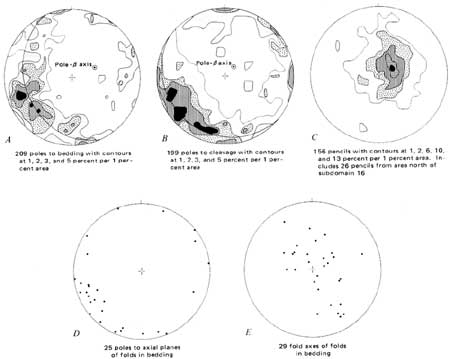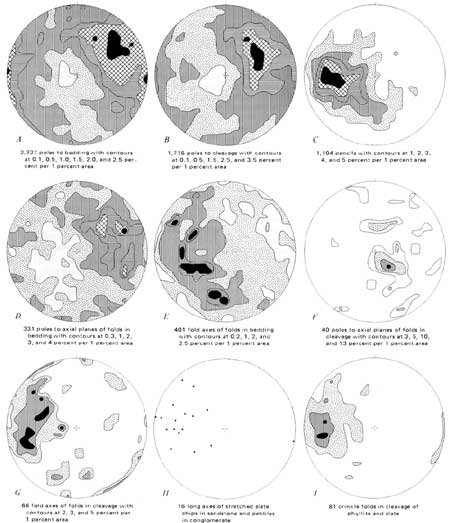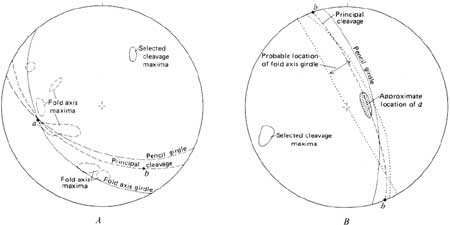
|
Geological Survey Professional Paper 1033
The Structure of the Olympic Mountains, Washington—Analysis of a Subduction Zone |
STRUCTURAL GEOLOGY OF THE EASTERN CORE
(continued)
MULTIPLE FOLDING
EARLY FOLDING—FORMATION OF THE CORE UNITS
The arcuate structural packets of broken formations that make up the eastern core of the Olympic Mountains probably formed when the depositional sequence (fig. 27A) was folded and faulted (fig. 27B, C). A scheme of this sort, though highly simplified, can be used to explain both the distribution of rocks of various ages in the eastern core units and the overturning of beds away from the core. In figure 27C, the west-facing limbs of the major folds are shown sheared off. The style of folding and sense of yielding in the early stages of the deformation (fig. 27B) are suggested by structures in the western core, where folds are overturned westward (Stewart, 1970, pl. 1; Rau, 1975), and on the northwestern peninsula, where the Crescent Formation is thrust over younger rocks (P. D. Snavely, Jr., written commun., 1976; fig. 3). Eastward underthrusting without large-scale folding could also account for the structures in the eastern core. Considerable disruption of bedding probably took place in this early stage of large-scale folding and or thrusting. The formations were broken.

|
| FIGURE 27.—Development of the eastern core by folding, faulting, and shear folding. Diagram is simplified because deformation and deposition may have gone on at the same time and may have been episodic. |
Horizontal fold axes or other B lineations formed at this stage are not evident in the eastern core. As we will show, early fold axes have been rotated by later shear folding. The arcuate bend of the core units did form in this early stage, for the bend controls the orientation of later-formed structures, and the bend indicates that the basaltic horseshoe was forming or already extant. This horseshoe could have formed during this early stage of deformation, or, as an initial reentrant formed by the arcuate distribution of several volcanic seamounts (see Cady, 1975, p. 575), it could have been enhanced as the rocks of the core, predominantly sedimentary, were pressed into and against the more rigid basalt.
The similarity of structural fabric in the peripheral rocks (subdomains 2A and 2B) adjacent to the main fault separating core rocks from peripheral rocks is to be expected in this scheme (see discussion of "Major Structural Terranes"). Although the rigid mass of basalts protected the peripheral rocks from being highly deformed, they were acted upon by the same forces.
The entire eastern core has the aspect of a large steeply plunging fold sheared off on the south side. Although there is no independent way of showing that the peripheral rocks have been folded into the horseshoe configuration (see Cady, 1975, p. 578), a pole diagram of bedding attitudes in the basaltic horseshoe crudely defines a b fold axis that plunges steeply eastward (fig. 28). In Domain East, the B elements (fig. 30) do not in any way parallel this "fold." In Domain West, the B lineation and b axes of beds and cleavage (fig. 29) generally correspond to this axis, suggesting that at some stage in the deformation the basaltic horseshoe either influenced structures in Domain West or developed with them.

|
| FIGURE 28.—Ninety-five poles to bedding in volcanic rocks in the Crescent Formation within lower 1-3 km of main part of basaltic horseshoe. Overturned beds, mostly in northeast part of horseshoe, were left out. Contours at 1, 2.1, 4.2, 5.3, and 7.4 percent per 1 percent area plotted by hand. |

|
| FIGURE 29.—Summary diagrams for structural elements in Domain West. (click on image for an enlargement in a new window) |
The southern fault zone must have developed in this stage, for structures parallel to it are rearranged by later cleavage (see below) and it seems to be a part of the horseshoe fold. Although some of the major rock units are truncated by the fault zone, others curve around sharply to the southwest to parallel the southern arm of the horseshoe. On an outcrop scale, north- to northeast-trending bedding is broken and rotated by shear movement along later northwest-trending cleavage; bedding maxima (fig. 26) reflect the rearranged bedding even though the gross lithologic units curve around to the southwest. Subdomain 18 contains elements of both the fault zone and later northwest-trending cleavage.
LATE FOLDING AND DOMING—FORMATION OF THE PENCILS
Summary diagrams for Domain East (fig. 30) indicate considerable complexity, but the data reveal major features of the structure not as well shown in the subdomains. In Domain East, there is considerable scatter of orientations, especially of bedding, cleavage, and axial planes, a pattern to be expected in multiple folding. From the field evidence, we have assumed that rocks were deformed predominantly by shear folding, and we have not considered flexural slip in the following analysis. In figure 31A a selected maximum for the summary cleavage s-pole diagram (fig. 30B) is plotted as a principal cleavage orientation that approximately coincides with the partial girdle in the summary diagram for pencils (fig. 30C). This principal cleavage orientation is well represented by cleavage s-pole maxima in subdomains 1, 2B, 4, 5, 6, 7, 9, and 11. In southern subdomains 13 and 15, few cleavages correspond to this orientation.

|
| FIGURE 30.—Summary diagrams for structural elements in Domain East. (click on image for an enlargement in a new window) |
Cleavage of the principal orientation is probably one of the principal planes bounding the late-formed pencils, hence is itself late formed. It intersects earlier planar structures of diverse orientation (mostly earlier formed cleavage and subparallel bedding which are isoclinally folded as well as partially bent around into the arc of the basaltic horseshoe; see strikes of bedding and cleavage in fig. 26). The summary fold-axis girdle (fig. 30E) intersects the principle cleavage in projection at a (fig. 31A). Most fold axes represent bedding-plane folds that probably formed in the earlier stage in the deformation. They have been rotated in a plane that defines the girdle (great circle) of figure 30E. Fold-axis maxima near a may indicate that the late shear folds are in part isoclinal. Ideally, the late shear folding, if isoclinal, rotates earlier formed fold axes into the a direction. Intersection a represents a west-plunging line (kinematic a) that parallels the direction of movement during the latest stage in shear folding (Weiss, 1959, p. 100-103). The latest movement in Domain East, then, was in general east-west direction on shear planes (cleavage) dipping southwest. The b kinematic axis for this late shear folding should lie in the cleavage, 90° from a (fig. 31A).
Axes of crinkle folds and folds in cleavage (fig. 30I) tend to lie in the synoptic fold-axis girdle, indicating that they too are earlier formed B structures. As they themselves formed after cleavage had formed, they indicate multiple shear folding prior to the last stage of shear folding under consideration here. Although stretched-clast lineation (fig. 30H) usually coincides with the a direction, probably indicating extension in the east-west direction, the small amount of data, especially in subdomains to the northeast, precludes recognition of a possible girdle. If the long axis of the clasts lay in the plane containing the fold axes, some clasts at least would have to parallel earlier formed B elements.
Summary diagrams for Domain West display a fair monoclinic symmetry with a steeply dipping northeast-striking symmetry plane (fig. 29). They are not so amenable to the same analysis as Domain East because they contain much less data and the pencil girdle is less discrete (fig. 29C), making identification of a late cleavage less certain. The summary pencil diagram (fig. 29C) contains data from the area north of subdomain 16 (figs. 24, and 25), where pencil structure is poorly defined. This area was not otherwise included in the analysis, partly because of sparsity of well-developed cleavage, but the pencils help define a partial girdle.
There is considerable continuity in pencil structures across the eastern core, suggesting they all formed by the same process. The fan of cleavage from east to west suggests that the pencils formed together in the latest stage of deformation and that, on the west, steeply eastward-dipping late cleavage and earlier planar structures controlled pencil formation. By analogy to the features discussed for Domain East, then, a weak girdle of early-formed fold axes (fig. 29E) intersects a principal cleavage plane near a possible pencil girdle at a (fig. 31B). At 90° from a in the cleavage is the b axis of the late shear folding. It is subhorizontal and trends north northwest; its proximity to the theoretical b axis for Domain East shows the results of the analysis for the two domains to be consistent. In Domain West, the a movement direction is roughly parallel to the monoclinic symmetry plane of the total structural fabric, as is required by the symmetry.
The late shear folding is present in both major domains. The direction of yielding, based on the orientation of a, was steeply up and westward in Domain West and more gently up and eastward in Domain East. The analysis of only two major domains has generalized kinematic direction a into two directions, whereas actually it probably is distributed in a fan from west to east, radiating upward from a sub-horizontal north-northwest-trending b axis. We picture a mushrooming dome, with fan of cleavage, extended asymmetrically to the east (fig. 27D).
| <<< Previous | <<< Contents >>> | Next >>> |
pp/1033/sec1c.htm
Last Updated: 28-Mar-2006
